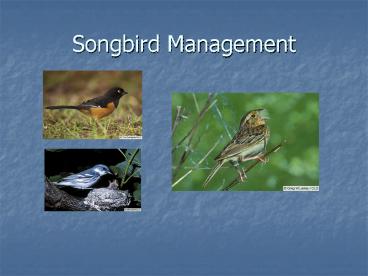Songbird Management - PowerPoint PPT Presentation
1 / 41
Title:
Songbird Management
Description:
Greatest Declines in Prairie Regions. Regional Declines ... Golden-Winged Warbler (Vermivora chrysoptera. Golden-Winged Warbler. Declining ~10.8%/yr ... – PowerPoint PPT presentation
Number of Views:210
Avg rating:3.0/5.0
Title: Songbird Management
1
Songbird Management
2
Why Manage for Songbirds?
Who Cares???
3
Population Trends
- Continental Declines
- Greatest Declines in Prairie Regions
- Regional Declines
- 70 of those declining are grassland species
- 41 species are increasing
4
Causes of Songbird Decline
- Potential Causes
- Habitat Loss, Degradation, or Fragmentation
- Migratory Routes
- Breeding Grounds
- Wintering Grounds
- Reproductive Issues
5
(No Transcript)
6
Issues along Migratory Routes
- Also habitat loss and associated decrease in food
availability
7
Habitat Loss
- Conversion of early-successional landscape to
mature forest - Urban and Recreational Development
- Mining
- Forest Health Management
- Invasive Plant Species
- Habitat loss in wintering grounds
8
(No Transcript)
9
Habitat Fragmentation
- Creates edge effects
- Increases susceptibility to Opportunists
- Limits opportunities Area-sensitive species
10
Reproductive Issues
- Brood Parasitism
- Nest Predation
- Hybridization
11
Habitat Suites
- Often conflicting priorities between Early and
Late-successional habitats and species - What is the true baseline for historical presence
and importance - Management different in each suite
12
Mature Deciduous Forest
13
Habitat Use
- Species use different components of a forest
landscape - Successional Stage (mid-late)
- Elevation
- Canopy
- Shrub
- Ground
- Snags
14
(No Transcript)
15
Species of Interest/Concern
- Cerulean Warbler (Dendroica cerulea)
- Great Crested Flycatcher (Myiarchus crinitus)
- Kentucky Warbler (Oporornis formosus)
- Worm-Eating Warbler (Helmitheros vermivorum)
16
Cerulean Warbler
- Declining over breeding range
- Habitat Requirements
- Tall complex canopy
- Large tracts of land
17
Songbird Management in Deciduous Forests
- Should address microhabitat needs
- Maintain a balance of forest-age structures
- Ensure long-term tree-species composition
- Maintain structural diversity
- Minimize levels of fragmentation
18
Riparian/Bottomland Forest
19
(No Transcript)
20
Species of Interest/Concern
- Cerulean Warbler (Dendroica cerulea)
- Louisiana Waterthrush (Seiurus motacilla)
- Acadian Flycatcher (Empidonax virescens)
21
Louisiana Waterthrush
- Prefers large tracts (gt100 ha)
- Requires clean, rapidly flowing water
- Rare in fragmented areas or those with poor water
quality
22
Songbird Management in Riparian Forests
- Minimize timber activity near forested riparian
areas - Maintain wide riparian forest corridors
(preferably 100 meters)
23
Shrub - Early Successional
24
(No Transcript)
25
Species of Interest/Concern
- Appalachian Bewicks Wren (Thryomanes bewickii)
- Golden-Winged Warbler (Vermivora chrysoptera
26
Golden-Winged Warbler
- Declining 10.8/yr
- Prefers dense patches of herbs/shrubs with few
trees - Favor mid-size (10-15 ha) patches
- Susceptible to hybridization nest
parasitism/predation
27
Songbird Management in Early-Successional
Landscapes
- Primary Goal Maintain areas in
early-successional stage - Possible cooperators
- Power Companies
- Mining Companies
- Promote value of shrub/scrub habitat to the public
28
Grasslands
29
(No Transcript)
30
Species of Interest/Concern
- Henslows Sparrow (Ammodramus henslowii)
- Loggerhead Shrike (Lanius ludovicianus)
- Dickcissel (Spiza americana)
31
Henslows Sparrow
- Continentally Very Rare
- Regionally Strong
- Prefers tall unmowed hayfields reclaimed
surface mines
32
Songbird Management in Grasslands
- Enhance existing agricultural and reclaimed mine
sites - Consolidation of adjacent fields
- Prescribed fire to control woody growth
- Mowing
33
Songbird Monitoring Techniques
- Abundance Species Composition
- Spot or Territory Mapping
- Point Counts Line/Point Transects
- Demographic Monitoring
- Capture Marking (Mist-nets)
- Nest Surveys
- Radio Tracking
- Migration counts
34
(No Transcript)
35
Methods to Assess Abundance-What Birds How
Many
- Point Counts
- Fixed or Variable Radius
- Dependent on Habitat
- Line Transects (set or variable distance)
- Cover greater area than point counts
- More Difficult statistically
- Spot Mapping
- Provides density specific life history info
- Expensive labor intensive
36
Spot Mapping (Territory Mapping)
- Map identity activity of all birds (or focal
species) - Ex. songs, calls, aggressive encounters
- Over several visits, clusters of sightings should
occur indicate individual territory
- Note Effective with territorial species ONLY.
37
Point Counts Transects
- Record activity at a fixed/variable distance over
a set time - Type depends on habitat complexity
38
Demographic Assessment
- Mist-nets
- Provides information on productivity and
survivorship of populations - Limited by area covered
- Monitors many species at one time
- Nest Monitoring
- site-specific and habitat-specific information on
productivity and reproductive status. - VERY labor intensive.
39
Nest Surveys
Requires Excellent Observational Skills Luck
40
Songbird Management Monitoring Programs
- Partners in Flight (PIF)
- North American Breeding Bird Survey (BBS)
- Audubon Christmas Bird Count
- WatchList
- Project Feeder Watch
41
- FIELD ASSISTANTS NEEDEDMay August, 2009Fort
Necessity National BattlefieldFarmington,
PAIndividuals needed to help with a research
project examining the effects of invasive
honeysuckle on wildlife populations. The work
will involve mist-netting and banding of
songbirds as well as performing call counts, and
nest monitoring. This project also includes
small mammal and amphibian trapping as well as
invertebrate collection and vegetation surveys.
Applicants should have knowledge of songbird or
small mammal identification and be willing to
work in a variety of terrain and weather
conditions. Additional training will be
provided.Pay 1000 - 1100/month Housing
Interested? Send a resume to Holly McChesney at
hmcches1_at_mix.wvu.edu.































